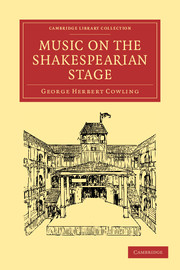Book contents
- Frontmatter
- PREFACE
- Contents
- LIST OF ILLUSTRATIONS
- Introduction
- CHAP. I Music in pre-Shakespearian drama
- CHAP. II An Elizabethan Stage and its music
- CHAP. III Musical instruments and their uses
- CHAP. IV Incidental music
- CHAP. V Musicians, Singers and Songs
- CHAP. VI Elizabethan music, and its share in the drama
- CHAP. VII Some literary allusions to music in Elizabethan plays
- Bibliography
- Appendix
- Index
CHAP. IV - Incidental music
Published online by Cambridge University Press: 07 September 2010
- Frontmatter
- PREFACE
- Contents
- LIST OF ILLUSTRATIONS
- Introduction
- CHAP. I Music in pre-Shakespearian drama
- CHAP. II An Elizabethan Stage and its music
- CHAP. III Musical instruments and their uses
- CHAP. IV Incidental music
- CHAP. V Musicians, Singers and Songs
- CHAP. VI Elizabethan music, and its share in the drama
- CHAP. VII Some literary allusions to music in Elizabethan plays
- Bibliography
- Appendix
- Index
Summary
Although music was introduced with the utmost freedom into the action of Elizabethan plays, there were certain conventional uses observed corresponding to the part a modern theatre orchestra fulfils in playing an overture, entr'actes, and accompanying songs, or in playing music to increase the emotional tension of a scene. Indeed our use of the orchestra in pure drama is a debt we owe to the men who made English drama. Our English custom of associating music with drama must have been handed down from the time of Shakespeare. It cannot be a loan from opera; for since the days of Davenant and Purcell, opera in England has always been a forced and outlandish kind of drama, never fixed in popular support, but flourishing when the fashionable world lent its approval, and dying when it turned its fickle face another way.
In the age of Shakespeare, no overture was played before the curtain rose. There was no curtain to rise. The custom was to play three blasts on the trumpet or sackbut from the topmost story before the speaker of the prologue entered to speak his lines. It was no new thing to blow trumpets at the beginning of a meeting. It was common at tournaments and at fairs. The church had done the like on certain feast-days. In some places musicians were sent up the church-tower to play before the celebration of festival masses. The custom still lingers in a few old-world towns.
- Type
- Chapter
- Information
- Music on the Shakespearian Stage , pp. 65 - 73Publisher: Cambridge University PressPrint publication year: 2009First published in: 1913

